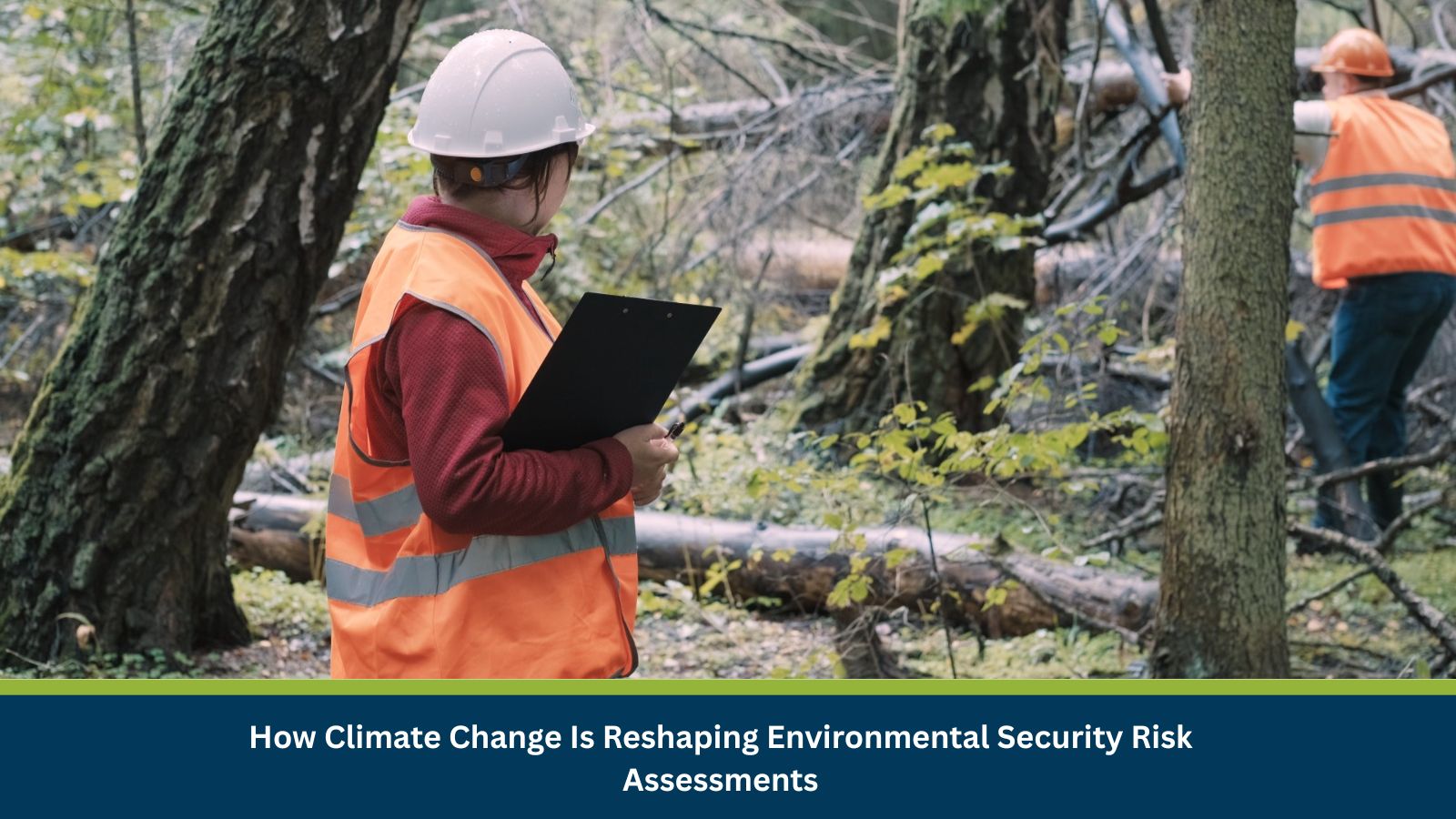Climate Change
Climate Change has rapidly shifted from being a scientific debate to a defining business and security challenge of the 21st century. Extreme weather events, rising sea levels, and resource scarcity are no longer distant scenarios they are unfolding realities with direct implications for governments, businesses, and communities. For organizations operating in an interconnected global economy, the risks are not confined to physical damage alone; they extend to disrupted supply chains, changing regulations, reputational pressures, and financial instability.
This evolving landscape underscores why Environmental Security Risk Assessments are becoming vital tools for decision-makers. Once focused narrowly on localized environmental threats, these assessments now serve as strategic instruments for identifying systemic vulnerabilities, quantifying financial exposures, and shaping resilient business models. To understand the urgency, it is essential to look at the hard data that highlights the magnitude of Climate Change and its cascading consequences.
The Stakes: Climate Change in Numbers
The scale of Climate Change is best captured in numbers, and the evidence is unequivocal. According to the World Economic Forum, each 1 °C increase in global temperature could erode as much as 12% of global GDP staggering figure that is six times higher than earlier estimates. A Reuters report, citing a Potsdam Institute–backed study, projects annual climate-related damages of US $38 trillion by 2050, encompassing losses across productivity, infrastructure, health, and agriculture.
A Deloitte survey of over 2,100 executives found that 70% expect climate change to have a high or very high operational impact in the next three years, with nearly half already adjusting business models in response. Yet, the 2024 EY Climate Action Barometer revealed a troubling gap: while 94% of large firms recognize climate risk, only 19% have implemented mitigation measures.
Collectively, these data points emphasize that climate risks are already material, accelerating, and systemic. For businesses, this reality makes Environmental Security Risk Assessments indispensable, shifting them from theoretical exercises to core strategic imperatives.
Why Climate Change Forces a Paradigm Shift in Risk Assessment
Traditional risk assessments focused largely on localized hazards- flood zones, storms, supply chain disruptions. But Climate Change introduces multi-dimensional, compounding risks:
- Cascading systemic risks- A drought in one region may trigger geopolitical tensions, migration, supply shortages, regulatory stress, and litigation, all of which must feed into Environmental Security Risk Assessments.
- Temporal horizons expand- Climate risks unfold over decades. Risk models must incorporate long tails, tipping points, and non-linear dynamics.
- Transition risks- Regulatory shifts, carbon pricing, stranded assets, and investor pressure are no longer peripheral; they are central to modern Environmental Security Risk Assessments.
- Interdependency and network effects- Modern supply chains are complex. A climate disaster in one node propagates risk across the entire chain.
- Valuation impact- Recent academic work shows that extreme high temperatures (above ~30 °C) correlate with measurable declines in firm asset values.
Thus, Climate Change forces risk assessment frameworks to evolve into dynamic, integrated systems rather than static checklists. Environmental Security Risk Assessments must now account for physical, transition, liability, reputational, and systemic risks.
Business Impacts: Domains Where Climate Change Alters Risk
Let’s explore key dimensions where climate reshapes business risk:
Infrastructure & Operations
Flooding, storms, sea-level rise, heat stress, physical climate hazards damage plants, transport networks, data centers, and energy grids. For instance, more than half of the top 100 global data centre hubs are now rated high or very high risk for climate stress, with trends worsening.
Supply Chain & Inputs
Agriculture, water, raw materials, energy – all are climate-sensitive. A drought in a raw-material region might cascade into production shocks downstream.
Regulation & Policy
Governments are tightening emissions rules, carbon pricing, climate disclosure mandates (e.g. EU’s CSRD, SEC climate proposals). Failure to adapt can lead to fines, stranded assets, and reputational loss.
Finance, Insurance & Credit
Insurers are already de-risking in flood-prone or wildfire zones; credit institutions and investors are integrating climate risk into ratings, capital buffers, and portfolio decisions. Tools like UNEP FI’s Sustainability Risk Tool Dashboard help financial players map evolving environmental and social risk.
Market & Customer Behavior
Consumers are increasingly willing to pay premiums for sustainable goods. Simultaneously, public opinion and activism push stronger climate expectations on corporates.
How to Integrate Climate Change into Environmental Security Risk Assessments
To be robust and credible, modern risk assessments must evolve. Below are advanced practices:
- Develop Multi-Scenario Stress Testing
Use a mix of climate scenarios (e.g. 1.5 °C, 2 °C, 3 °C warming) and stress test business units under extreme “shock” events (e.g., “100-year floods,” “heatwaves,” “carbon price shock”).
- Use Spatial & Geospatial Analytics
Map facility locations, supply nodes, critical infrastructure, and overlay climate hazard layers (flood maps, heat maps, drought indices). Leverage climate data providers and indices.
- Quantify Economic & Valuation Impacts
Translate physical and transition exposure into financial metrics: future profits, asset write-downs, cost of capital impacts, valuation multiples. Academic models (e.g. temperature–asset value regressions) provide guidance.
- Integrate Governance & Strategic Oversight
Ensure Board level awareness, climate‐risk committees, and tie climate KPIs into executive compensation and investment decisions.
- Build Adaptive Pathways
Don’t rely on a single plan. Construct branching “adaptive pathways” with trigger thresholds (if flood reaches X, then relocate; if carbon price hits Y, then shift supply).
- Engage Stakeholders & External Expertise
Partner with climate think tanks, NGOs, academic labs, and global institutions. Use frameworks from bodies like the UN, World Economic Forum, or the Task Force on Climate-related Financial Disclosures (TCFD).
At MitKat, we guide clients to embed sophisticated Environmental Security Risk Assessments that factor in Climate Change dynamics, bridging cutting-edge science and business strategy.
Recommendations for Business Leaders
- Start early and iterate. Don’t wait until regulation forces you; begin integrating climate scenarios now.
- Raise internal capacity. Build climate, data, and adaptation expertise into your risk and strategy teams.
- Link finance and strategy. Use internal carbon pricing, shadow pricing, or carbon budgeting to stress test business lines.
- Forge partnerships. Collaborate with research institutions, climate data providers, and global bodies.
- Communicate transparently. Use external links (e.g. to UN reports, WMO) in your disclosures to back your analyses and credibility.
- Pilot adaptation investments. Test climate-resilient infrastructure, nature-based solutions, or supply-chain de-risking in smaller parts of your operations before scaling.
Conclusion
Climate Change is no longer a hypothetical externality; it is a force reshaping Environmental Security Risk Assessments at their core. The data is overwhelming: tens of trillions in costs, shrinking GDP, climate disasters multiplying, firms losing valuation under temperature stress.
To remain viable, businesses must evolve their risk models to incorporate the complexity, uncertainty, and systems thinking that Climate Change demands. With the right approach and institutional support, Environmental Security Risk Assessments can become strategic assets shaping resilient, adaptive organizations rather than reactive ones.
For organizations aiming to adopt this rigorous, climate-aware stance, explore MitKat’s advisory capabilities in integrating Environmental Security Risk Assessments into your governance and strategy pipeline.
Your Security Partner
MitKat’s Datasurfr platform delivers real-time, AI-powered risk intelligence, filtered and contextualised by expert analysts to support proactive decision-making. Paired with our Protective Services, we turn intelligence into action, safeguarding your leadership wherever they operate. Collaborate with MitKat to build true business resilience. From Risk Consulting and Security Design to Cyber Security and Protective Services, our integrated solutions help organisations navigate today’s complex threat landscape and build robust, future-ready risk management frameworks.






